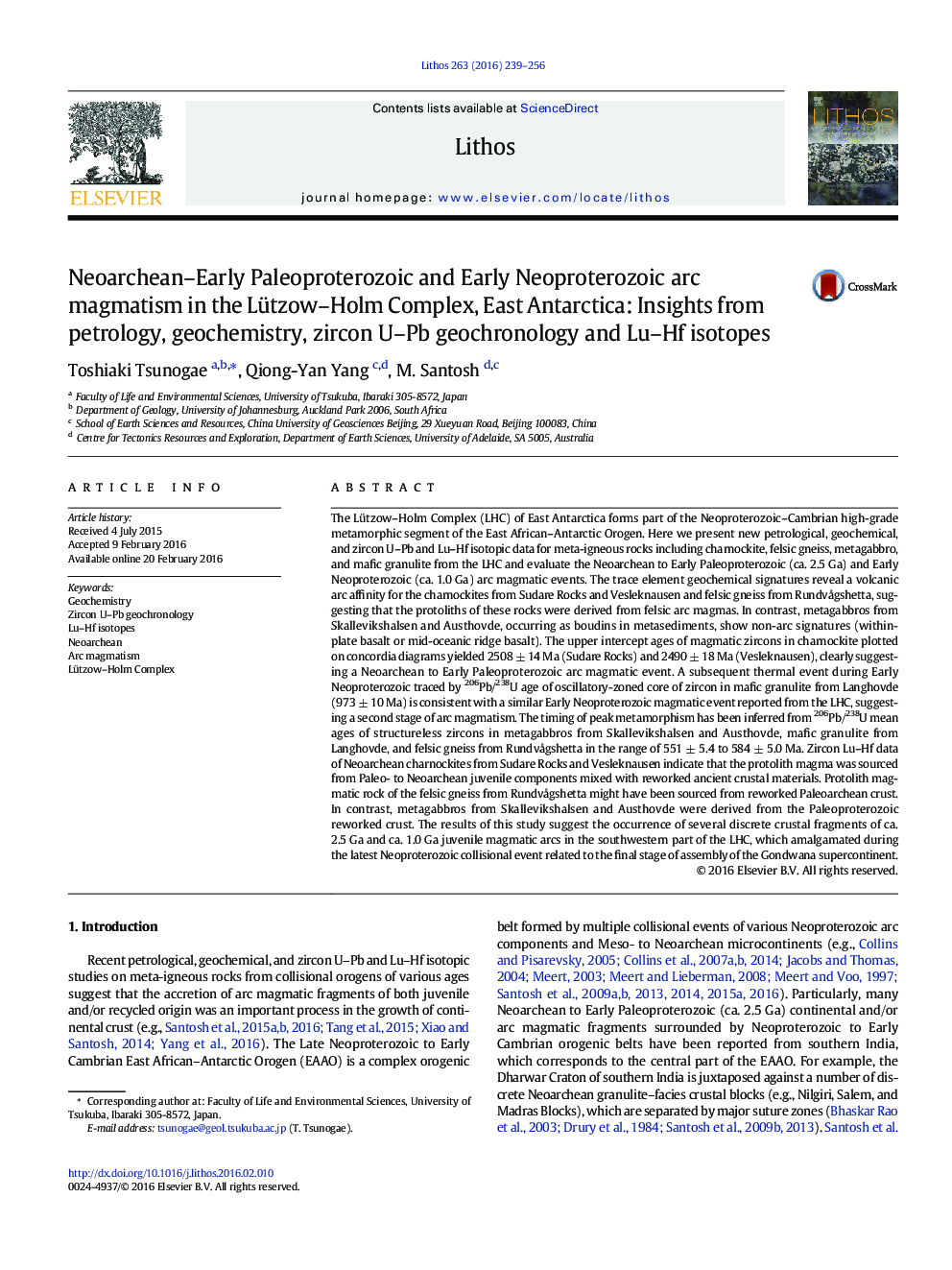| کد مقاله | کد نشریه | سال انتشار | مقاله انگلیسی | نسخه تمام متن |
|---|---|---|---|---|
| 4715476 | 1638641 | 2016 | 18 صفحه PDF | دانلود رایگان |

• Volcanic arc affinity for charnockite and felsic gneiss from the Lützow–Holm Complex
• Upper intercept ages of 2508–2490 Ma suggesting a Neoarchean arc magmatic event
• Magma derivation from Meso- to Neoarchean juvenile components mixed with reworked crustal materials
• 551–584 Ma high-grade metamorphism related to a collisional event during Gondwana amalgamation
• Fragments of Neoarchean and Early Neoproterozoic juvenile magmatic arcs in the complex
The Lützow–Holm Complex (LHC) of East Antarctica forms part of the Neoproterozoic–Cambrian high-grade metamorphic segment of the East African–Antarctic Orogen. Here we present new petrological, geochemical, and zircon U–Pb and Lu–Hf isotopic data for meta-igneous rocks including charnockite, felsic gneiss, metagabbro, and mafic granulite from the LHC and evaluate the Neoarchean to Early Paleoproterozoic (ca. 2.5 Ga) and Early Neoproterozoic (ca. 1.0 Ga) arc magmatic events. The trace element geochemical signatures reveal a volcanic arc affinity for the charnockites from Sudare Rocks and Vesleknausen and felsic gneiss from Rundvågshetta, suggesting that the protoliths of these rocks were derived from felsic arc magmas. In contrast, metagabbros from Skallevikshalsen and Austhovde, occurring as boudins in metasediments, show non-arc signatures (within-plate basalt or mid-oceanic ridge basalt). The upper intercept ages of magmatic zircons in charnockite plotted on concordia diagrams yielded 2508 ± 14 Ma (Sudare Rocks) and 2490 ± 18 Ma (Vesleknausen), clearly suggesting a Neoarchean to Early Paleoproterozoic arc magmatic event. A subsequent thermal event during Early Neoproterozoic traced by 206Pb/238U age of oscillatory-zoned core of zircon in mafic granulite from Langhovde (973 ± 10 Ma) is consistent with a similar Early Neoproterozoic magmatic event reported from the LHC, suggesting a second stage of arc magmatism. The timing of peak metamorphism has been inferred from 206Pb/238U mean ages of structureless zircons in metagabbros from Skallevikshalsen and Austhovde, mafic granulite from Langhovde, and felsic gneiss from Rundvågshetta in the range of 551 ± 5.4 to 584 ± 5.0 Ma. Zircon Lu–Hf data of Neoarchean charnockites from Sudare Rocks and Vesleknausen indicate that the protolith magma was sourced from Paleo- to Neoarchean juvenile components mixed with reworked ancient crustal materials. Protolith magmatic rock of the felsic gneiss from Rundvågshetta might have been sourced from reworked Paleoarchean crust. In contrast, metagabbros from Skallevikshalsen and Austhovde were derived from the Paleoproterozoic reworked crust. The results of this study suggest the occurrence of several discrete crustal fragments of ca. 2.5 Ga and ca. 1.0 Ga juvenile magmatic arcs in the southwestern part of the LHC, which amalgamated during the latest Neoproterozoic collisional event related to the final stage of assembly of the Gondwana supercontinent.
Figure optionsDownload as PowerPoint slide
Journal: Lithos - Volume 263, 15 October 2016, Pages 239–256